Better Together
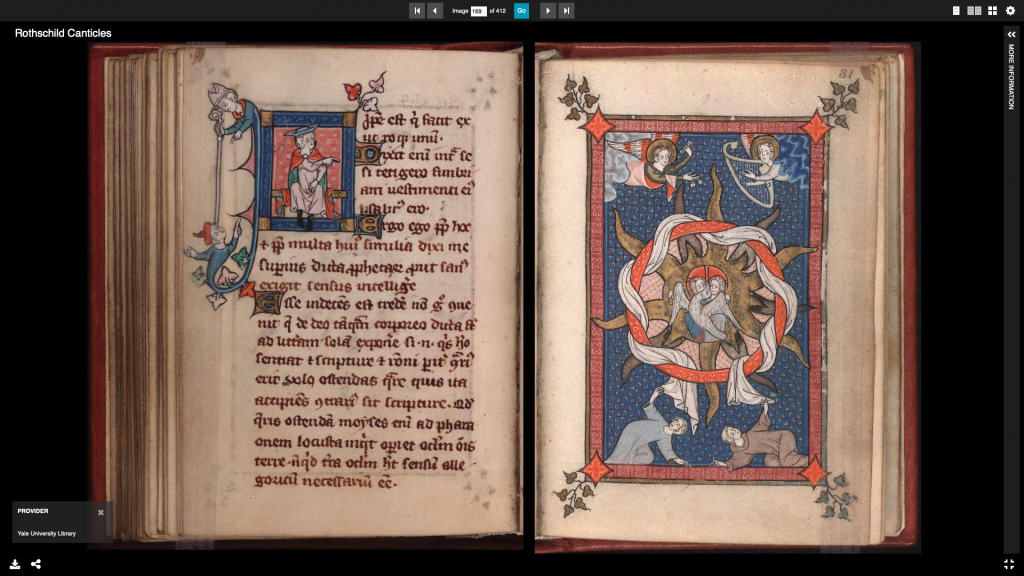
Among the holdings of the Yale University library is a richly illustrated little book (about 7” x 3”) known for a previous owner as The Rothschild Canticles. The Canticles are a collection of quotations from other sources including the Song of Solomon from the Bible and Augustine’s book On the Trinity and was likely intended to aid the personal devotions of an individual Christian.
The image above is of two of the pages about half-way through the book.
We are immediately struck by the richness and quality of the work. The drawings are carefully designed and skillfully rendered. The gold color is real gold leaf glued to the page and the blue and red inks which are lavishly used would have been made by hand through a labor intensive process.
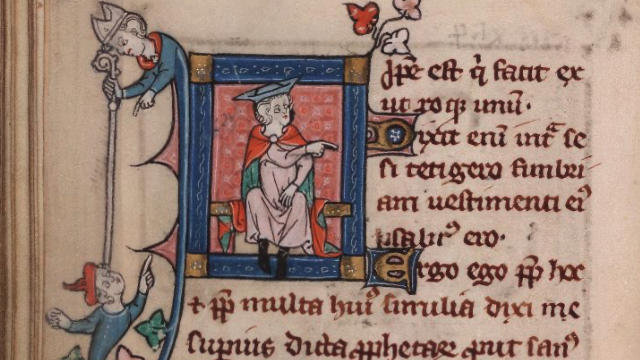
Continued attention to these pages and several others like it, show whimsical images. The figure in the upper left (above) points to the opposite page and draws our attention to what might be interpreted as a playful scene.
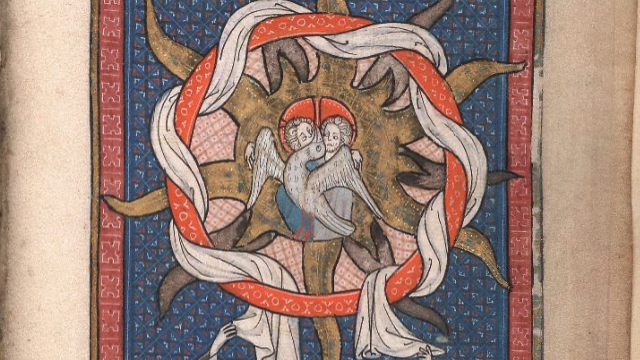
Two human-like figures embrace while a bird stands before them with wings outstretched. A closer look reveals hands holding each of the wings, indicating that all three figures are caught in an embrace. They strike this pose in the center of a burst of golden light which itself is surrounded by a patterned red ring around which is twisted a length of white fabric.
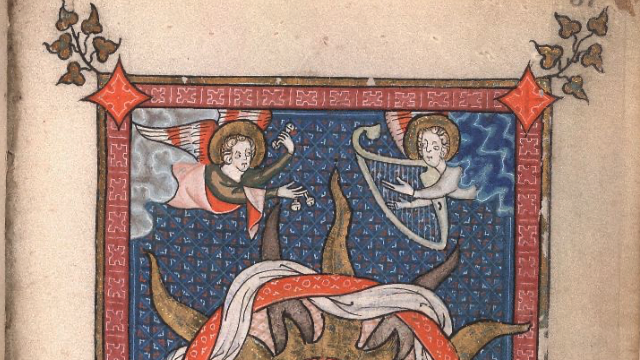
Two angels, one with bells and the other with a harp, appear out of the clouds above them, while two people (to me, a women in a blue dress on the left and a man in a monk’s habit on the right) kneel under it all, yet reaching up to grasp at the fabric frame.
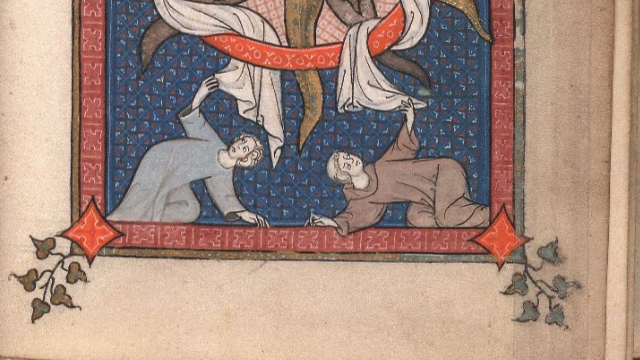
In the imagination of the artist, this is Father, Son and Holy Spirit caught in a dance to the music of angels while humans gaze in wonder.
The Triune God of the Christian faith – Father, Son, and Holy Spirit – dancing may not be the first idea that comes to mind as we think about the nature of God who is, after all, infinite and ultimately beyond our knowing. Yet, as Augustine himself observes, we can’t help but imagine God in human bodily form. The artist of the Canticles seems to be egging us on with the question, what is it for our God to be a community of three yet substantially one? The answer seems to be that the togetherness of God really matters.
Togetherness matters for us as well. We’ve all observed that one of the revelations of our pandemic-imposed isolation is just how critical social interaction is for our well being, both as individuals and collectively. As COVID restrictions have eased, almost all of us have flocked to gatherings and events that bring people together in one place. Almost everyone agrees, it’s good to get out and see people.
It can also be exhausting!
When we gather with other people, they bring their whole selves to the meeting – not just their image on the screen which we can mute or turn right off if they get difficult or we get distracted. Whole people are complicated and occasionally frustrating, even problematic. And when we show up in person, we bring our whole person too – not just the cultivated persona of our social media profiles. It’s unpredictable.
It can be messy.
It might even be anxiety inducing, especially when we add our own uncertainty about the future to the mix.
The temptation to disengage from it all is real – even if we all said we couldn’t wait to get out and see people again.
Helmut Thieleke, a theologian and pastor who worked and wrote in the midst of the crisis which was Nazi Germany, observed that the antidote for anxiety is love. We might, in our time, dismiss this as naïve and entirely simplistic – after all, our anxieties and uncertainties have real power in our lives. They are responses to real circumstances with real potential for harm – as we imagine it in our most vulnerable moments. How can something like “love” possibly combat such circumstances?
In a devotional essay entitled “I Am Not Alone with My Anxiety,” Pastor Thieleke notes that at the height of his suffering, while he hangs from the cross, Jesus cries out “My God, my God, why have you forsaken me?” When I’ve heard those words read on Good Friday, they’ve impressed me as evidence of Jesus’ utter abandonment. Can one be any more destitute than this – to be forsaken by the Father with whom you’ve claimed complete unity?
But Thieleke sees it differently. To his mind, the fact that Jesus has one to cry to at all means that he is not alone. There is someone else on the other side of this cry. The Father hears the Son and that is enough. Jesus, at the time of his greatest anxiety, has someone to whom he cries out and that someone hears – even if the cry is one of accusation. So great is the Father’s love.
But Jesus doesn’t just cry out for himself. His cry of abandonment is the cry of the alienated and self-alienating whole world. It is your cry when you’ve had it up to here and can’t take it anymore. Jesus cries out on our behalf, trusting that the Father will hear and love and that in that love there will be life.
After all, they’ve been dancing together for all eternity.
Pr. Jim
March 30, 2022
Rev. James A. Wetzstein takes turns writing weekly devotions with Rev. Katherine Museus Dabay at Valparaiso University, where both serve as university pastors.
Image: Rothschild Canticles. General Collection, Beinecke Rare Book and Manuscript Library, Yale University. Shailor, B. Catalogue of Medieval and Renaissance Manuscripts in the Beinecke Rare Book and Manuscript Library, MS 404.
- Archives of Devotional Writings from our Pastoral Staff
- “HELP!”
- “Some Lent!”
- (Your vocation here) of people
- A call to courage for 2021
- A charming tale for over-achievers
- A Lesson On Beans … and Being
- A New Place
- A Point of Privilege
- A season of anticipation
- A Time of Dust
- Acquiring a peaceful spirit
- Advent = Hope
- All will be well
- Anastasis: the Greatest Story of God’s Saving Power
- Another kind of darkness
- Are we willing to cross the road for one another?
- As if we needed a reminder
- Beacons of hope
- Better Together
- Blessings As You Go
- Borderlands
- Can we learn to be happy?
- Carrying the COVID Cross
- Come and See
- Did Jesus really suffer?
- Doing without in a life of plenty
- Don’t miss this moment
- Exiles with Vision
- Fear not!
- Fear of the Lord
- Feeling at Home
- Finding Purpose in the Journey
- Finding Words for Times Like These
- Forgiving others – and ourselves
- Getting ahead with Jesus
- Getting down on Jesus’ level
- Getting through this together
- God is not overwhelmed
- Good Friday
- Grief & Graduation
- Have yourself a merry little Christmas — somehow
- Holy Week and Taking Out the Trash
- Holy Week: The aid station late in the semester
- Hopes & Dreams vs Life in the Wilderness
- How do you keep from giving up hope?
- How glad we’ll be if it’s so
- I almost slipped
- Imagining Eternity
- In a time of uncertainty, these things are certain
- In everything, grateful
- In praise of plans B … C … D …
- In the midst of grief, God will bring life
- Is there such a thing as being too forgiving?
- It’s a Three Day Weekend!
- It’s In the Bag
- It’s What’s Happening
- Jesus among us
- Killing off our future selves
- Knowing a Good Thing When We See It
- Lessons in fire building
- Let there be light!
- Let us work for real wellness in our communities
- Life Is a Highway
- Lilies and leaves and whatever else is beautiful
- Living in the Present
- Naming our demons
- O Lord, you know I hate buttermilk
- Of Fear and Failure
- On Christian Unity: When we’re not one big happy church
- On the Bucket List
- On the day after the night before
- Overwhelmed
- Persistent and Extravagant
- Pray and Let God Worry
- Praying for Reconciliation
- Preparing for the world to be turned rightside up
- Recovering from an Epic Fail
- Reformation calls for examination
- Remembering among the forgetful
- Rest
- Rest is Holy
- Right where we are
- Seeing beauty in brokenness
- Signs of Love
- Starting Small
- Still in the storm
- Surprisingly Simple: Breathe!
- Taking a Break from the Relentless
- Talking ourselves into it
- Thankfulness leads to joyfulness
- The Art of Holy Week
- The Funny Business of Forgiveness
- The Greatest of These is Love
- The Magi: Exemplars of Faith and Learning
- The Power of Small Conversations
- The Trouble with Mammon
- The Power of Taking a Sabbath
- The Spiritual Gift of Hindsight
- This can’t be done alone
- To be known
- Too.Much.
- You might be a Lutheran if…
- You will be in our prayers this summer of 2020
- Ventures of which we cannot see the ending
- WWJD? We already know
- Walking in the Light of Jesus’ Resurrection
- We had hoped
- We’re on a mission from God
- What do you do with your anger?
- What good is a shepherd?
- What is your base reality?
- What to do after you find your voice
- What to do on the day after
- What we know and what we don’t know
- When bad things happen
- When God uses something terrible for good
- When heaven & earth click
- When joy and sadness live together
- When stress overwhelms
- When the promise of resurrection is hard to believe
- When you offer up your broken cup
- When we are moved
- Where God will be found
- Where is the good shepherd carrying you?
- Wilderness Journeys
- Won’t you be my neighbor?
- Year-end time management: Keeping the main thing the main thing
- Your Valpo roots will help you grow into your future